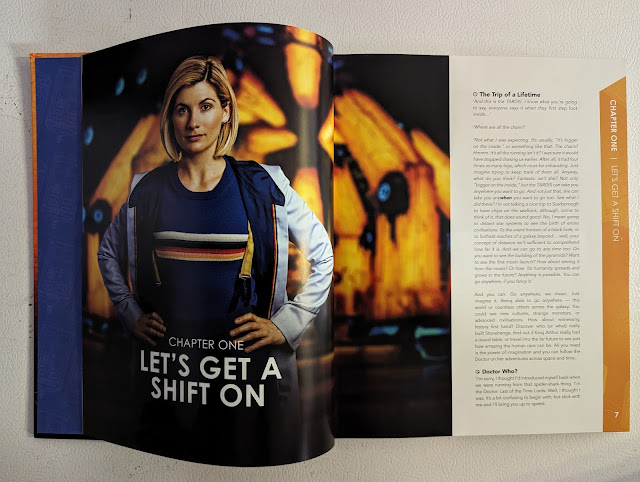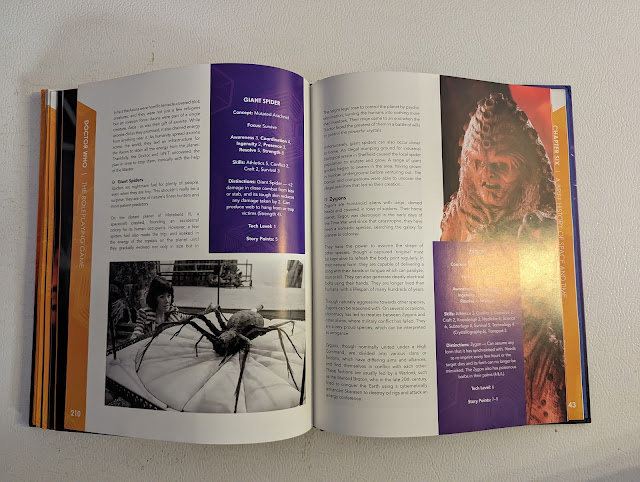I will do a full review, but also I want to cast an eye toward the differences in the game from the previous First Editon(s).
Doctor Who: The Roleplaying Game Second Edition
PDFs and Hardcover book. Full color. 256 pages.
PDF is broken down into Core rules, Doctor, Companions, and Pregen charactersheets, and a blank character sheet.
As always, I am considering the PDFs from DriveThruRPG as well as the Core Rules book from my FLGS.
New Doctor means new trade dress and rules from Cubicle 7. But this time C7 goes the extra step and gives us an all new rule book with new (ish) system. What's inside? Let's have a look.
The layout of the book is very similar to the previous hardcovers, so if you are moving to this game from the First Edition then things will be easy for you to find.
The table of contents is up first and immediately you get the idea that this edition is courting new players. Each chapter for example has a brief sentence describing what it is for starters.
Chapter One: Let's Get a Shift On
Upfront, just like the previous versions, this book focuses on the then-current Doctor, the 13th, played by Jodie Whitaker and her companions. Though the other Doctors are not forgotten here.
This is our introduction chapter and it orientates the reader on who the Doctor is, what RPGs are and this one in particular. There is some bits about using the metric system (the USA really needs to get with the rest of the world here) and if you have round, round down.
We end with an example of play.
If you are coming to this game from either the previous edition or the Starter Set then this chapter is familiar territory.
Chapter Two: Travellers in the Fourth Dimension
As with previous editions, this is our Character Creation chapter with new rules ahead. We start with a character concept in the form of "Who are you?" not a backstory but rather an idea of who your character is. There is a discussion about the tone of your game and how do the characters all get along. We get everything from the extended "fam" of the 13th Doctor to the group of UNIT operatives.
Note: The text here, while similar to previous editions, does not feel "copied and pasted" from other editions/versions. This does read like a new game, albeit one with some familiarity.
The game starts with your Concept. That is who this character is. So for a companion like Yaz she is a "Probationary Police Officer." Leela would be a "Primitive tribe member." This helps us figure out what our characters are.
Next we get to our Focus. From the rulebook: "Where a character’s Concept is ‘who they are’, their Focus is more of ‘what makes them tick?’" That is a good summary. A Focus has a benefit (adds a +1d6) and a flaw, which is just a restriction on what sort of actions you take. Continuing with the Yaz example her Focus could be "The Law" meaning she can get a bonus when acting with authority but maybe she wont want to participate in a little B&E. Now depending on the intensity of your Focus it could be a +1d6 or +2d6 or even a solid +6 to any roll.
Experiences cover things the character could have done already. Yaz has some experience with the Law due to her education and she has experience as the daughter of an immigrant family and so on. Don't have anything in mind? No worries there is a 1d6x1d6 grid to help you find out. Likewise there is one for shared background experiences. This is great since so many of the companions of the Doctor had these shared experiences. Ian and Barbara were both teachers at the same school, Teegan and Nyssa both had family members killed by the Master.
Once you have these then we get into your point buy Attributes. This is largely the same as the previous edition (and most point-buy games). These are still Awareness, Coordination, Ingenuity, Presence, Resolve, and Strength. Skills are also largely the same with 12 skills. Previous combat-related skills have been merged into the Conflict skill. There is a new "Intuition" skill now.
Distinctions are also new and these largely replace the Traits of the previous version. These are mostly things like "Time Lord" or "Cyberman" or "Sontaran." Taking these usually result in fewer Story Points. Humans get 12, a Sontaran might get 8, and an experienced Time Lord also 8.
Fill in some more background information, set your home Tech Level and you are ready to go. Once you play a bit you will collect experience points. The end of this chapter covers spending experience points.
Chapter Three: Sorting Out Fair Play Throughout the Universe
This chapter covers running a game. The basic rule is still pretty much the same.
ATTRIBUTE + SKILL + TWO SIX-SIDED DICE = RESULT
(try to match or beat the Difficulty of the task)
So now Distinctions can alter these rolls, but the basic gameplay is still the same. This includes the Success and Failure levels associated with the rolls.
This also covers spending (and regaining) Story Points.
Plenty of examples are given on how the rules manifest in game play but really this is one of those games where the rules seamlessly move into the background while you are playing.
One such example of this are contested rolls and the example is combat. Again, Doctor Who is not a "kill all the monsters and take their stuff" sort of game, but every so often there will be creatures that want you dead.
Along with this some weapons are detailed along with other equipment and vehicles.
Special care is given to gadgets which are now less regulated by the rules. Essentially they do what they need to do.
Chapter Four: A Big Ball of Timey-Wimey Stuff
This covers the basic of traveling in Time and Space with some details about how the TARDIS works and so on. There are other means mentioned, but the TARDIS is our state-of-the-art means. TARDISes in the game are built a lot like characters are. This was always part of the rules, but it is more front and center in this edition.
This chapter also covers the various issues with Time Travel.
Chapter Five: Hold Tight and Pretend It’s a Plan
This is our Gamemaster section. It covers how to run a game. From designing your first group of travelers to the big wide universe they live in. It covers how to set up a game and a series of adventures (a campaign). This material is very similar to previous editions. This is expected since the advice in those editions was great and spot on, no need to over do it or redo it.
This also covers dealing more and more with the companions lives and families. Companions took a more central role in the story of the Doctor with the updated series. Their job is not so much to scream, get captured, and ask "what is it Doctor?" Now they drive key elements of the story and the adventures.
Chapter Six: A Brief History of Space and Time
This covers the setting of the Doctor Who RPG which is at present all of Time and Space. So yeah fairly inclusive of everything. Special attention is paid to the Doctor's favorite planet, Earth. Which is good since that is the one the authors also know the most about.
This chapter covers a few monsters/creatures/aliens for you to encounter and more background on Time Lords and Gallifreyans. Attention is given here to the Master in all their incarnations.
We get details on the "big ones" of course, Daleks, Cybermen, Sontarans, Silurians, and Ice Warriors. Good mix of both Classic Who beasties and NuWho ones.
Appendix: Remember All the People You Used to Be
This covers converting your Doctor Who 1st Edition Characters over to the new Second Edition. Not a difficult process at all really. About the same as moving from say any edition to Call of Cthulhu to another. Less complicated than moving from 1st Edition AD&D to 2nd Ed AD&D to be sure.
We also get character sheets for the 13th Doctor, Graham, Yasmin "Yaz", and Ryan. There is a blank sheet, and a good Index.
Who is this Game For?
If you are new to RPGs and are a fan of Doctor Who then this is the game for you.
If you are not new to RPGs but new to Doctor Who then this game is also good. But that is not the real question is it.
Should I Switch/Upgrade?
If you have the First Edition Doctor Who RPG, any version, and you really love it I would say stick with that. Reading 2nd Edition books with a First Edition mindset is not difficult ad I pointed out with the Doctor Who Sourcebooks.
If you want to keep up with all the Doctor Who books, then yeah, this is a fine edition of the rules.
The trade-off between Traits (1st Ed) and Distinctions (2nd Ed) is largely one of taste. Traits are little crunchier and Distinctions require more buy-in from the Players and Gamemaster.
Honestly, I can see a game where Traits and Distinctions can co-exist and can be played in the same game. Traits are just a bit more codified.
The book itself is gorgeous with plenty of color photos from the show (and even some black & white ones) and while the 13th Doctor and her "fam" are predominate, all Doctors are represented here at least once.
For me? Well, let's build some characters and see if I can get what I want.







2 comments:
Sounds like that is the game I would buy if I were to buy a game. I suppose that would make sense to have the most current one--at this time.
Yes.
Here is why I think this one might be the best one for you.
- It is the most current
- It is very friendly to new players and new fans alike
- It removes some of the "Crunchy" bits for Narrative bits that also make it easier to run.
Plus it is a damn attractive book.
Post a Comment